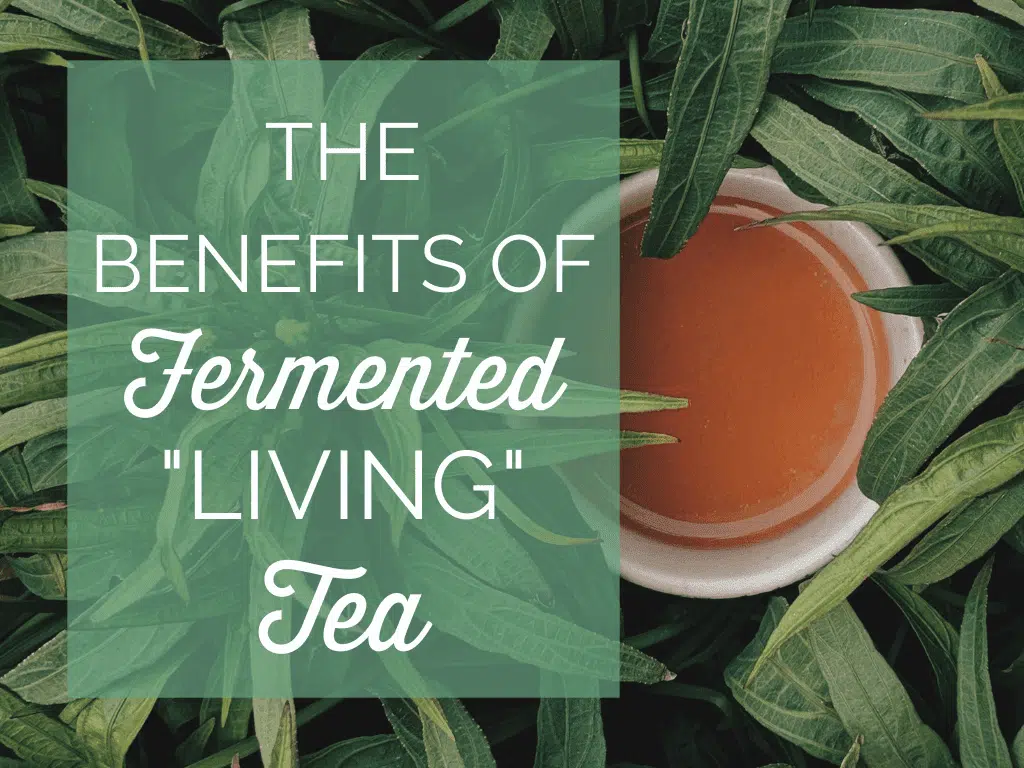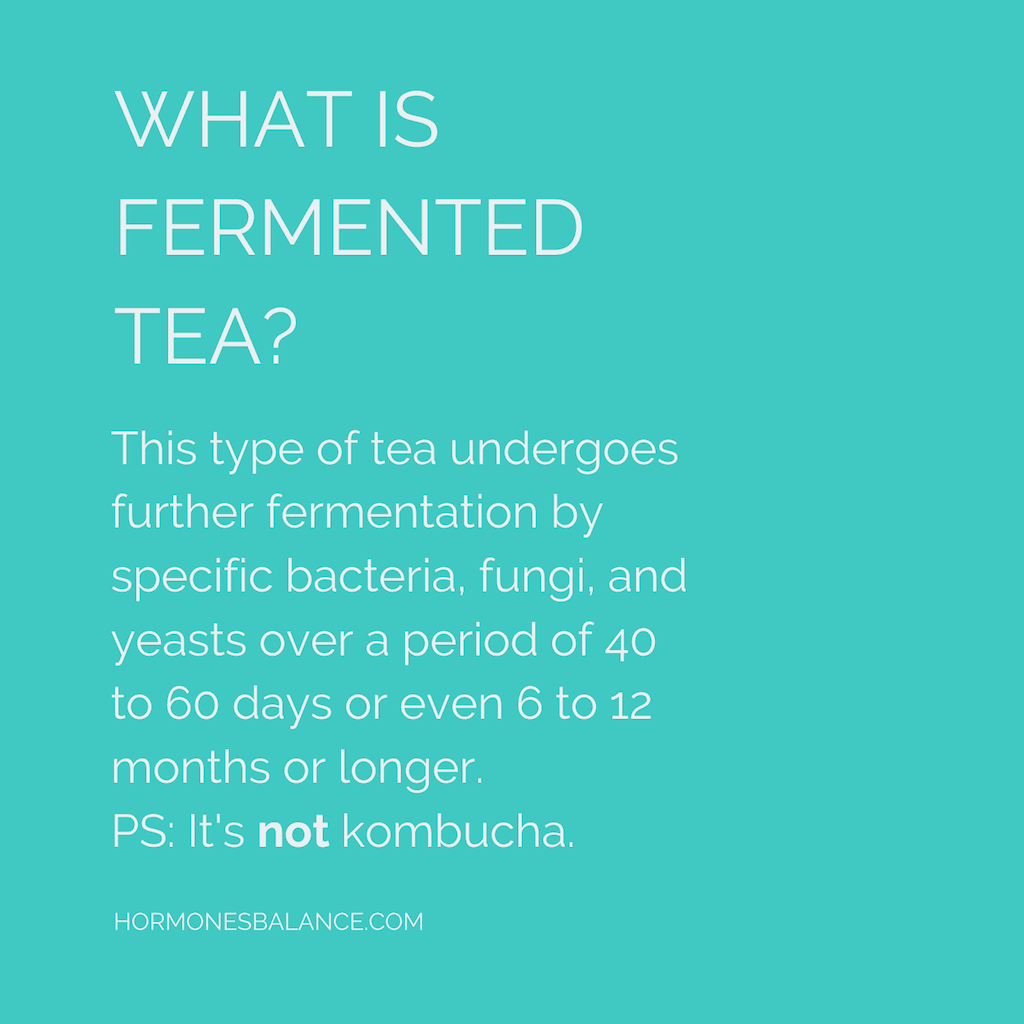What You Will Learn in This Article
- What is fermented tea
- Fermented tea benefits
- How fermented tea affects your hormones
- Where to get the best fermented tea
What is Fermented Tea?
Fermented tea (also called post-fermented tea or dark tea) is a tea made from a different varietal of the tea plant, Camellia sinensis assamica. This type of tea undergoes further fermentation by specific bacteria, fungi, and yeasts over a period of 40 to 60 days or even 6 to 12 months or longer. These beneficial microbes metabolize catechins from raw Camellia sinensis assamica into black tea flavonols. Some of the rarest, most sought-after teas are fermented for a decade or more, often with a price to match. It’s similar to the wine industry, where a bottle of wine can sell for thousands of dollars.
It’s important to note here that this tea is completely different from Kombucha, where you start with brewed tea and then add a SCOBY (Symbiotic Colony Of Bacteria and Yeast) to ferment the tea. This is a process of further fermentation of the tea leaves by microbes before any brewing takes place.
The most famous fermented tea is called Pu’er (or Pu-erh), pronounced poo-air, which comes from the Yunnan province of China. The Camellia sinensis assamica tree whose leaves are used in Pu’er tea is a much larger tree (30-50 ft) than the Camellia sinensis (10 ft) used in typical green, black, oolong, and white teas. Because this tree grows to such a large size, it develops root systems that go deep into the earth where they have access to a rich supply of minerals and other nutrients. As a result, their leaves are a great source of all kinds of trace minerals and other rare compounds that they pass on to the tea drinker.
What’s interesting about post-fermented teas like Pu’er is that they continue to ferment on the shelf. These teas are “living” teas in which the microbes continue their fermentation work over time. While pu’er tea has one tenth the catechins of green tea, the overall antioxidant capacity is similar to green, oolong, and black teas. It has been suggested that the antioxidants supplied by pu’er may be produced by the microbes in the fermentation process. So, it may be the probiotic content that provides extra antioxidants from pu’er.
Two Types of Pu’er Teas
A partial fermentation of this tea produces Pu’er Green tea, which is considered raw. Fermentation continues as it’s stored (again, a “living” tea), creating more flavonols and a more complex flavor. The green pu’er is rich in tannins.
Complete fermentation produces Pu’er Black (ripe) tea, which is considered “ripe.” The fermentation process produces polyphenols called theaflavins and thearubigins. Black pu’er is lower in tannins, making it easier on sensitive stomachs.
Benefits of Fermenting Tea
When high quality, organic tea is fermented, it is taken to the next level in wellness. Not only does it contain innate powerful polyphenols to fight inflammation, it also now contains additional antioxidants, plus probiotics to promote immune health, digestive health, and general health and vitality.
While research on the chemical components and health benefits of Pu’er and other fermented teas is still fairly limited, traditional uses for pu’er include increasing energy levels, weight loss, digestive health, detoxification, and promoting relaxation. Despite the fact that we are still just beginning to tap into the possibilities of this amazing tea, the potential, given the probiotic content, prebiotic components, and antioxidant potential, is very promising.
Studies have already shown its anti-obesity and anti-tumor abilities. It’s also been shown to be helpful for cardiovascular disease. I’ll share more benefits and research related to hormone balance below.
How Does Fermented Tea Affect Hormones?
Improving the Gut Microbiome
Fermented tea, including pu’er, seems to alter the balance of the gut microbiome in favor of bacteroidetes while reducing numbers of firmicutes. This indicates potential in lessening markers for metabolic syndrome (the precursor to type II diabetes) and weight gain. Less fat means fewer estrogen-producing fat cells. And as we know, gut bacteria are the boss of your hormones.
Also check out these two videos on The Connection Between Gut Bacteria, Hormones, and FAQs.
Lowering Blood Sugar
Fermented tea may be especially beneficial for balancing blood sugar. An animal study published in a 2015 issue of Food & Function found pu-erh tea polysaccharides to be better at stabilizing blood sugar levels than the anti-diabetic drug, Acarbose, without the negative side effects.
And a 2018 meta-analysis of animal studies found that pu-erh tea could be helpful in lowering fasting blood sugar levels. A higher dose of Pu-erh tea polysaccharides (160 mg per kg^-1) was more effective than a lower dose (80 mg per kg^-1) and daily consumption for at least 3 weeks was necessary to get the full benefits in lowering blood sugar.
Keeping blood sugar balanced is important for keeping the hormone insulin balanced. If insulin spikes too often, it can lead to lower levels of sex hormone binding globulin (SHBG), which binds excess estrogen and testosterone. If SHBG is low due to constant blood sugar fluctuations, these hormones increase, leading to estrogen dominance and other downstream problems.
Balancing Estrogen
Tea polyphenols inhibit aromatase. Aromatase is an enzyme that converts testosterone to estrogens (estrone and estradiol).
This is significant because inhibiting aromatase is a strategy that has been used to treat postmenopausal estrogen receptor-positive breast cancer. In fact, researchers in this study concluded that “Aromatase inhibitors appear to be superior to tamoxifen as first-line endocrine option in [postmenopausal metastatic breast cancer] women.”
Aromatase inhibitors from tea polyphenols and other sources can help address estrogen dominance.
Where to Get the Best Fermented Tea
Not all pu’er teas are equal in quality and purity. Because the pu’er tea plant is so good at absorbing minerals, it can also concentrate metals like aluminum, lead, cadmium, mercury, zinc, copper, and arsenic. Testing must be done to ensure safety –especially if drinking greater quantities of otherwise health-promoting teas is a goal.
For that reason and others, if you’d like to experience the benefits of fermented tea, I highly recommend the brand Pique, which I’ve also talked about in articles here and here.
Pique teas are triple toxin screened for heavy metals, plus pesticides and mold. They have been analyzed by the Fresenius Institute in Germany, a top lab analysis company that’s been in the business for over 150 years. The results confirm that Pique teas are extremely clean and not only meet but surpass organic standards.
Pique tea uses a technique called Cold Brew Crystallization™ to make their tea crystals. This process can take up to 8 hours per batch. Just like making cold brew coffee, cold brew crystallization uses cold water to create the infusion.
Antioxidants can be damaged by heat, so the cold brew process helps to preserve as many antioxidants as possible so that you get the maximum benefit from each cup of tea. In fact, third-party testing has confirmed that Pique teas have up to 12 times the polyphenols of other comparable teas.
After the tea has been brewed and all the phytonutrients extracted, the water is slowly removed using low-temperature dehydration and pressure. What’s left is a super potent tea concentrate in the form of crystals.
Fermented Pu’er super teas by Pique
According to Pique Tea Founder, Simon:
“The Pu’er Fermented Teas are the best teas that Pique or any tea company has ever launched… and likely ever will.”
Simon Cheng, 3x Gold Medalist record breaker, 2018 Global Tea Championships.
Why is This Particular Tea So Special?
Since Pique teas already have up to 12 times the polyphenols of other teas, the benefits are multiplied when a high quality Pu’er is given the Pique tea system of processing.
What goes into Pu’er teas by Pique:
- Camellia sinensis assamica leaves, the most concentrated in polyphenols of any tea varietal
- Leaves sourced from 250 year old trees in a pristine, untouched forest near the Himalayan mountains
- Roots of these trees reach deeper into the earth than any other tea plant found thus far on the planet
- The deep-reaching roots draw rare minerals and other nutrients up into the tree and into the leaves
- Beneficial microbes which ferment the leaves into a rich, dark tea
The results:
- A healthy dose of concentrated polyphenols, full of antioxidants
- Beneficial microbes which remain in active fermentation aiding in gut health and a strong and balanced immune system
- Delicately processed tea that retains its antioxidant profile through the use of minimal heat and pressure
- A potent “tea concentrate” that is truly therapeutic to the body
- A beneficial beverage that revitalizes cells and brings health and energy to the tea drinker
Cautions
While fermented tea has beneficial effects for many, it’s not for everyone. If you happen to have histamine intolerance or mast cell issues, fermented foods are going to mostly be out for a while. And that includes fermented tea.
Additionally, keep in mind the pu-erh tea does have caffeine, which means it’s not good in large amounts for those who are pregnant or nursing. It may also worsen symptoms of Irritable Bowel Syndrome (IBS), if loose stools are an issue. If you’re on any medication that interacts with caffeine, always check with your healthcare practitioner before indulging too much.
However, for most people, up to 3 cups a day can safely be enjoyed.
Pique Tea Offer for Hormones & Balance Readers
Pique Tea has a special offer for Hormones Balance readers, so that you can enjoy the major health benefits of Pu’er tea.
You can get up to two FREE cartons of Jasmine green tea crystals if you purchase a Pu’er tea bundle. Here’s how.
Order the Essential Bundle (complete with one carton Green Pu’er and one carton of Black Pu’er), and get one FREE carton of Jasmine green tea (a $12 value).
Or, stock up on these super teas with the Ultimate Bundle (complete with two cartons Green Pu’er, and two cartons Black Pu’er), and get two FREE cartons of Jasmine green tea (a $24 value).
The leaves used to make the Pu’er teas are rare and Pique only has a limited supply. They will sell out.
Get your cartons of Pu’er Tea here.
Resources:
https://journals.plos.org/plosone/article?id=10.1371/journal.pone.0157847
https://www.ncbi.nlm.nih.gov/pubmed/21793506
https://www.ncbi.nlm.nih.gov/pubmed/17880152
https://www.ncbi.nlm.nih.gov/pmc/articles/PMC3233424/
https://www.mdpi.com/2072-6643/11/10/2364/htm
https://www.ncbi.nlm.nih.gov/pubmed/25820466
https://onlinelibrary.wiley.com/doi/full/10.1111/ijfs.13966
https://www.ncbi.nlm.nih.gov/pubmed/7962291
https://www.ncbi.nlm.nih.gov/pmc/articles/PMC2848451/
https://www.ncbi.nlm.nih.gov/pubmed/15341993
https://www.ncbi.nlm.nih.gov/pubmed/11399122
https://www.ncbi.nlm.nih.gov/pmc/articles/PMC2361349/
https://www.deepdyve.com/lp/elsevier/exposure-and-risk-assessment-for-aluminium-and-heavy-metals-in-puerh-20jgApI12l
https://link.springer.com/article/10.1007%2Fs11655-011-0781-4
Photography by Aniketh Kanukurthi


I’ve heard that the good bacteria or fermented bacteria is killed by heat therefore wouldn’t all the benefits from the pur ea tea be “killed” when pouring hot water to it?
Thanks
Hi Celeste, that’s a great question. Yes temperature is important here. You do not want to use water over 170 degrees Fahrenheit otherwise you do risk deactivating those wonderful good bacteria. ~HB Support